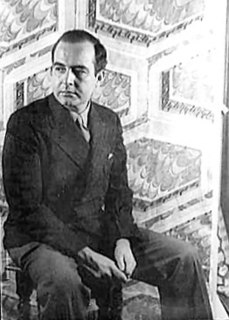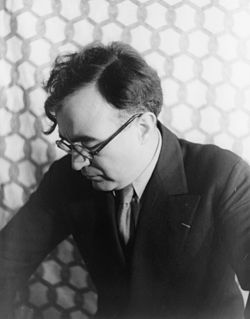Related Research Articles

Samuel Osmond Barber II was an American composer, pianist, conductor, baritone, and music educator. One of the most celebrated composers of the 20th century; music critic Donal Henahan stated, "Probably no other American composer has ever enjoyed such early, such persistent and such long-lasting acclaim." Principally influenced by nine years of composition studies with Rosario Scalero at the Curtis Institute and more than twenty-five years of study with his uncle, the composer Sidney Homer, Barber's music usually eschewed the experimental trends of musical modernism in favor of utilizing traditional 19th-century harmonic language and formal structure that embraced lyricism and emotional expression. However, elements of modernism were adopted by Barber after 1940 in a limited number of his compositions, such as an increased use of dissonance and chromaticism in the Cello Concerto (1945) and Medea's Dance of Vengeance (1955), and the use of tonal ambiguity and a narrow use of serialism in his Piano Sonata (1949), Prayers of Kierkegaard (1954), and Nocturne (1959).

Zubin Mehta is an Indian conductor of Western and Eastern classical music. He is music director emeritus of the Israel Philharmonic Orchestra (IPO) and conductor emeritus of the Los Angeles Philharmonic.

The Piano Concerto No. 5 in E♭ major, Op. 73, by Ludwig van Beethoven, popularly known as the Emperor Concerto, was his last completed piano concerto. It was written between 1809 and 1811 in Vienna, and was dedicated to Archduke Rudolf, Beethoven's patron and pupil. The first performance took place on 13 January 1811 at the Palace of Prince Joseph Lobkowitz in Vienna, with Archduke Rudolf as the soloist, followed by a public concert on 28 November 1811 at the Gewandhaus in Leipzig under conductor Johann Philipp Christian Schulz, the soloist being Friedrich Schneider. On 12 February 1812, Carl Czerny, another student of Beethoven's, gave the Vienna debut of this work.

The Double Concerto in A minor, Op. 102, by Johannes Brahms is a concerto for violin, cello and orchestra. The orchestra consists of 2 flutes, 2 oboes, 2 clarinets, 2 bassoons, 4 horns, 2 trumpets, timpani and strings.
The Piano Concerto, Op. 38, by Samuel Barber was commissioned by the music publishing company G. Schirmer Inc. in honor of the centenary of their founding. The premiere was on September 24, 1962, in the opening festivities of Philharmonic Hall, now David Geffen Hall, the first hall built at Lincoln Center for the Performing Arts in Manhattan, with John Browning as soloist with the Boston Symphony Orchestra conducted by Erich Leinsdorf.
Charles Ives's Symphony No. 1 in D minor, written between 1898 and 1902, is an example of how Ives synthesized ideas from composers who came before him. Many of his later symphonies relied on Protestant hymns as the main theme. However, this symphony is composed in the late-Romantic European tradition, and is believed to contain many paraphrases from famous European pieces such as Tchaikovsky's Pathétique and Schubert's Unfinished symphonies and especially Dvořák's New World Symphony.
Samuel Barber's Concerto for Violoncello and Orchestra, Op. 22, completed on 27 November 1945, was the second of his three concertos. Barber was commissioned to write his cello concerto for Raya Garbousova, an expatriate Russian cellist, by Serge Koussevitzky on behalf of Garbusova and the Boston Symphony Orchestra. Funds for the commission were supplied, however, by John Nicholas Brown, an amateur cellist and a trustee of the Boston Symphony Orchestra. The score is dedicated to John and Anne Brown. Barber was still on active duty with the U. S. Army at the time he received the commission, and before beginning work asked Garbousova to play through her repertoire for him so that he could understand her particular performing style and the resources of the instrument. Garbousova premiered it with the Boston Symphony Orchestra in Symphony Hall, Boston, on 5 April 1946, followed by New York performances at the Brooklyn Academy of Music on 12 and 13 April. The concerto won Barber the New York Music Critics' Circle Award in 1947.

Igor Stravinsky's Violin Concerto in D is a neoclassical violin concerto in four movements, composed in the summer of 1931 and premiered on October 23, 1931. It lasts approximately twenty minutes.
Glenn Dicterow, is an American violinist and former concertmaster of the New York Philharmonic Orchestra. He is on the faculty of The Juilliard School and Manhattan School of Music, as well as a faculty artist at the Music Academy of the West, following three years of participation in Music Academy Summer Festivals. He also holds the Robert Mann Chair in Strings and Chamber Music at the University of Southern California's Thornton School of Music.
Capricorn Concerto, Op. 21, is a composition for flute, oboe, trumpet and strings by Samuel Barber, completed on September 8, 1944. A typical performance lasts approximately 14 minutes.
The Piano Concerto No. 1, Sz. 83, BB 91 of Béla Bartók was composed in 1926. Average playing time is between 23 and 24 minutes.
Samuel Barber's Essay for Orchestra, Op. 12, completed in the first half of 1938, is an orchestral work in one movement. It was given its first performance by Arturo Toscanini with the NBC Symphony Orchestra on November 5, 1938 in New York in a radio broadcast concert in which the composer's Adagio for Strings saw its first performance. It lasts around 8 minutes and is dedicated "To C.E." The essay is now known as the First Essay for Orchestra after Barber wrote his Second Essay for Orchestra in 1942. He also wrote a Third Essay in 1978.

Sharon Kam is an Israeli–German clarinetist. She won the ARD International Music Competition in 1992.
Roger John Goeb was an American composer.

Sinfonía india is Carlos Chávez's Symphony No. 2, composed in 1935–36. In a single movement, its sections nevertheless follow the traditional pattern for a three-movement symphony. The title signifies the fact that the thematic material consists of three melodies originating from native-American tribes of northern Mexico. The symphony is Chávez's most popular composition.
The Symphony No. 1, H. 289, is an orchestral composition by the Czech composer Bohuslav Martinů.
Symphony No. 2, Op. 19 is a three-movement work for orchestra by the American composer Samuel Barber. The 25-minute work was originally written in 1944. The work underwent many revisions and was finally published in 1950. The original manuscript was withdrawn by Barber in 1964. He ordered that G. Schirmer destroy the original manuscript and all scores in their library. The work remained unpublished for many years until 1984 when a set of parts turned up in a warehouse in England. Renewed interest in Barber's work led to a 1990 reprint of the 1950 edition.

Concerto for Piano with Orchestra is a composition by the Mexican composer Carlos Chávez, written between 1938 and 1940.

Symphony No. 2, Op. 17, in A major by the Romanian composer George Enescu was written in 1912–14. A performance lasts about 55 minutes.

The Symphony No. 3, Op. 21, in C major is a large-scale orchestral-vocal composition by the Romanian composer George Enescu, written in 1916–18.
References
- Alps, Tim. 1980. "Concerto: Modern". Music and Musicians 28 (January): 66.
- Heyman, Barbara B. 1992. Samuel Barber: The Composer and His Music. New York: Oxford University Press.
- Heyman, Barbara. 2012. Samuel Barber: A Thematic Catalogue of the Complete Works. Oxford and New York: Oxford University Press. ISBN 978-0-19-983795-3.
- Simmons, Walter. 1981. "Barber: Essay No. 3". Fanfare 4 (May–June): 49–50.
- Simmons, Walter. 2004. Voices in the Wilderness: Six American Neo-romantic Composers. Lanham, MD: Scarecrow Press. ISBN 978-0-8108-4884-9
- Taylor, Benedict. "Nostalgia and Cultural Memory in Barber's Knoxville: Summer of 1915". The Journal of Musicology 25, no. 3 (Summer 2008): 211–29.
Footnotes
- ↑ "Mrs. J. H. Wickersham Entertain at a Tea". New York Times (May 22, 1951). p. 36.
- ↑ Heyman 1992, pp. 498–9; Heyman 2012, p. 468.
- ↑ Ericson, Raymond. 1978. "Mehta Plans Barber Premiere to Open Philharmonic Season". The New York Times (March 14, 1978). p. 30.
- ↑ "Deaths". New York Times (April 23, 1978). p. 36.
- ↑ Phillips, Julie. 2006. James Tiptree, Jr.: The Double Life of Alice B. Sheldon. New York: St. Martin’s Press. ISBN 978-0-312-42694-1.
- ↑ Heyman 1992, pp. 502–3; Heyman 2012, p. 468.
- 1 2 Ramey, Phillip. 1981. "A Talk with Samuel Barber". In John Corigliano: Concerto for Clarinet and Orchestra; Samuel Barber: Third Essay for Orchestra, Op. 47. Stanley Drucker, clarinet; New York Philharmonic; Zubin Mehta, cond. LP recording, 1 disc: 12 inch, 33⅓ rpm, stereo. Recorded Anthology of American Music. New World Records NW 309. Liner notes, 3–4. p. 4.